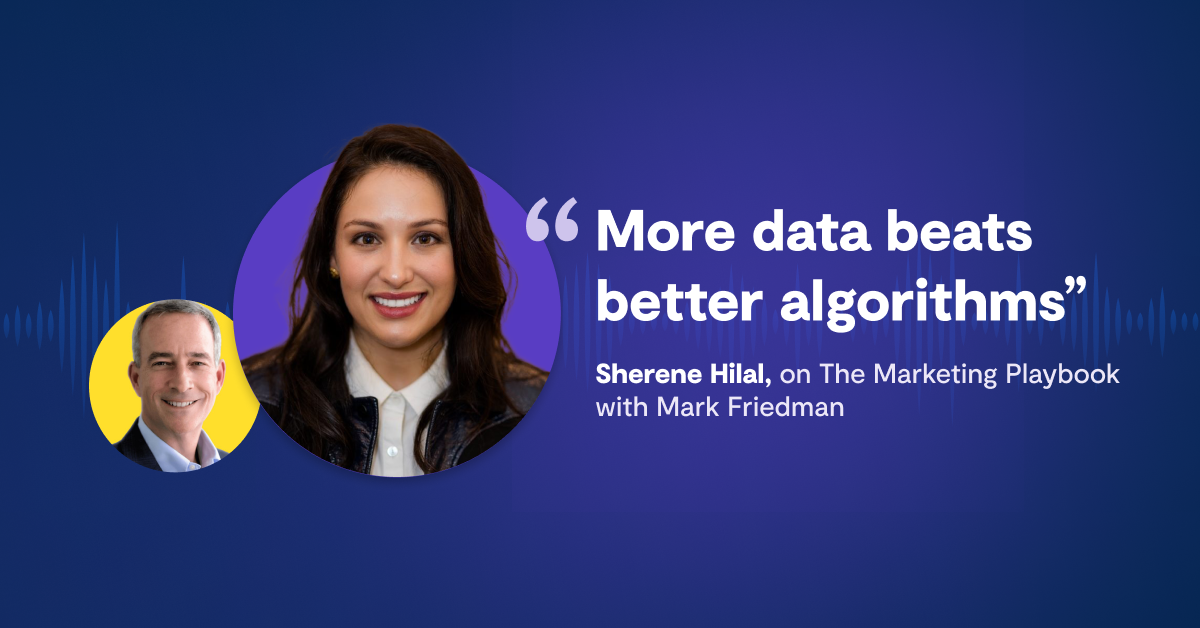

An Insider Look at Data-Driven Retail with Bluecore CPO Sherene Hilal
Sherene Hilal, Chief Product Officer at Bluecore, didn’t set out to change the way retailers engage with customers. She was working on the ad side at Condé Nast when a chance encounter with a data company’s CEO led her to uproot her life, move across the country to Seattle, and start a whole new career in data-driven retail.
In the 12 years since that fateful day, she’s cut a wide swathe through the industry, helping create the first data management platform and pioneer Data-as-a-Service as a viable offering. Since 2018, she’s been working at Bluecore, applying her extensive experience to revolutionize the way retailers move customers through the purchase funnel.
Recently, Sherene appeared on The Marketing Playbook podcast, hosted by Mark Friedman. In addition to revealing some fascinating personal history (for instance, the fact that her grandmother was the first woman in Egypt to attend college), Sherene walked Mark through some of the challenges in data-driven retail, and how brands might go about addressing them.
Below, you’ll find four key takeaways from Sherene’s podcast appearance, touching on such subjects as data management, the Request for Proposal process, and the perennial difficulties of engaging — and retaining — new customers.
1. “More data beats better algorithms”
Marketers have long believed the right algorithm could send their sales into the stratosphere. Today, that logic is more often applied to AI: find the right tool, flick the ‘On’ switch, and watch the sales roll in — or so the thinking goes.
But, as Sherene points out, this idea is only half-right. Just as the world’s most powerful car can’t run without gas, the world’s most powerful AI can’t function without high-quality data. Without it, you’ll just be spinning in place. Or, as Sherene likes to say, in a phrase she first heard from an early-career mentor: “More data beats better algorithms.”
“A lot of people think AI is this crystal ball,” Sherene says. But these technologies are “completely dependent on the data that feeds into it.”
And in the world of data-driven retail, quality isn’t the only consideration. How that data is structured matters, too. Too often, retailers silo their data, treating their many channels (website, app, in-store, etc.) as discrete entities and missing crucial signals in the process.
The most cutting-edge technology on the market can only do so much for you if your data “isn’t clean and can’t be consumed in a structured way.”
2. The importance of data-driven retail outcomes during the RFP process
Retailers tend to enter the RFP process with certain set ideas in mind. As Sherene points out, they’ll draw up a list of the thirty things their last martech partner did, throwing in two or three extra competencies that partner lacked.
But a retailer-martech relationship is like any other relationship. If you set out with a specific list of traits you’re looking for, and refuse to deviate from that list, you’re going to miss out on potentially transformative experiences.
The focus for any data-driven retail organization should instead be on outcomes.
“Oftentimes, the employees are seen as driving the outcome, and the system is thought of as facilitating that outcome,” she says. “When instead, the state of technology right now is such that it should be able to drive the outcome.”
It’s part and parcel of what Sherene describes as a “shuffling deck chairs mentality,” or a tendency on the part of some retailers to stick to what they already know, to diminishing returns.
That said, this process goes both ways. If a potential tech vendor is making grand claims on behalf of its products during the RFP process, brands shouldn’t hesitate to ask for evidence in advance. “One of the things I encourage every brand to do is ask for proof of concept,” Sherene says. “If a tech vendor is telling you they’re great at X or Y, but can’t deliver X or Y in a reasonable timeframe, they’re probably not very good at it—and you should think twice about partnering with them.”
3. Don’t neglect your non-purchasers
There’s a reason that all existing customer analytics systems are oriented toward customers who have already purchased from them, and with good reason: repeat buyers remain the core of any retailer’s business,
But as Sherene points out, there is another category that is just as essential: those who have sent definite interest signals but who haven’t made a purchase yet.
Right now there is a “huge opportunity to move nonbuyers in,” and many brands are failing to capitalize on it. Converting those non-buyers to buyers is at the core of Customer Movement, which Sherene describes as “how you move a shopper through your purchase funnel.”
Many data-driven retail organizations don’t even realize how many opportunities they’re missing out on because siloed channels prevent them from seeing the things that “fall in between the seams,” as Sherene puts it.
Part of the solution here, for retailers, is overhauling their conception of “identification rate.” Many retailers will say they have a 100% identification rate, but they’ll be referring exclusively to people who have already purchased from them. However, true 100% identification means being able to identify every customer, from casual browsers to those actively moving down the purchase funnel.
These customers are just as essential to a comprehensive data-driven retail sales strategy, and with the right targeting efforts can quickly be converted to repeat purchasers — but this can only happen if you know who they are.
As Sherene puts it, it’s essential not to forget “the 90% of your non-purchasers that you need to be able to reach.” By leveraging quality data, brands can find precisely the right product or offer to get those customers to make a first — and then a second, and then a third — purchase.
4. Data-driven retail metrics: purchase frequency and cross-category buying
Identifying a purchaser is important, but in a sense, it represents the baseline. That’s because many retailers have what Sherene calls “a one-and-done buyer problem.” Retailers spend and spend to get a buyer to make a purchase — and wind up with a net loss when that buyer never comes back. Per Sherene, this is fundamentally a “technology failure,” a matter of retailers failing to re-engage buyers with data-driven retail marketing.
But let’s say that a buyer does make a second purchase. As Sherene points out, it is the rare retailer that only operates in a single category. A buyer making a purchase in two separate categories, especially in a relatively short period, is among the strongest indicators there is of lifetime buying potential.
Paying attention to just these two metrics, says Sherene, can get retailers “90% of the way there.” For most retailers, this is good news: after all, they already have this data at their disposal. All they need to do now is leverage it.




